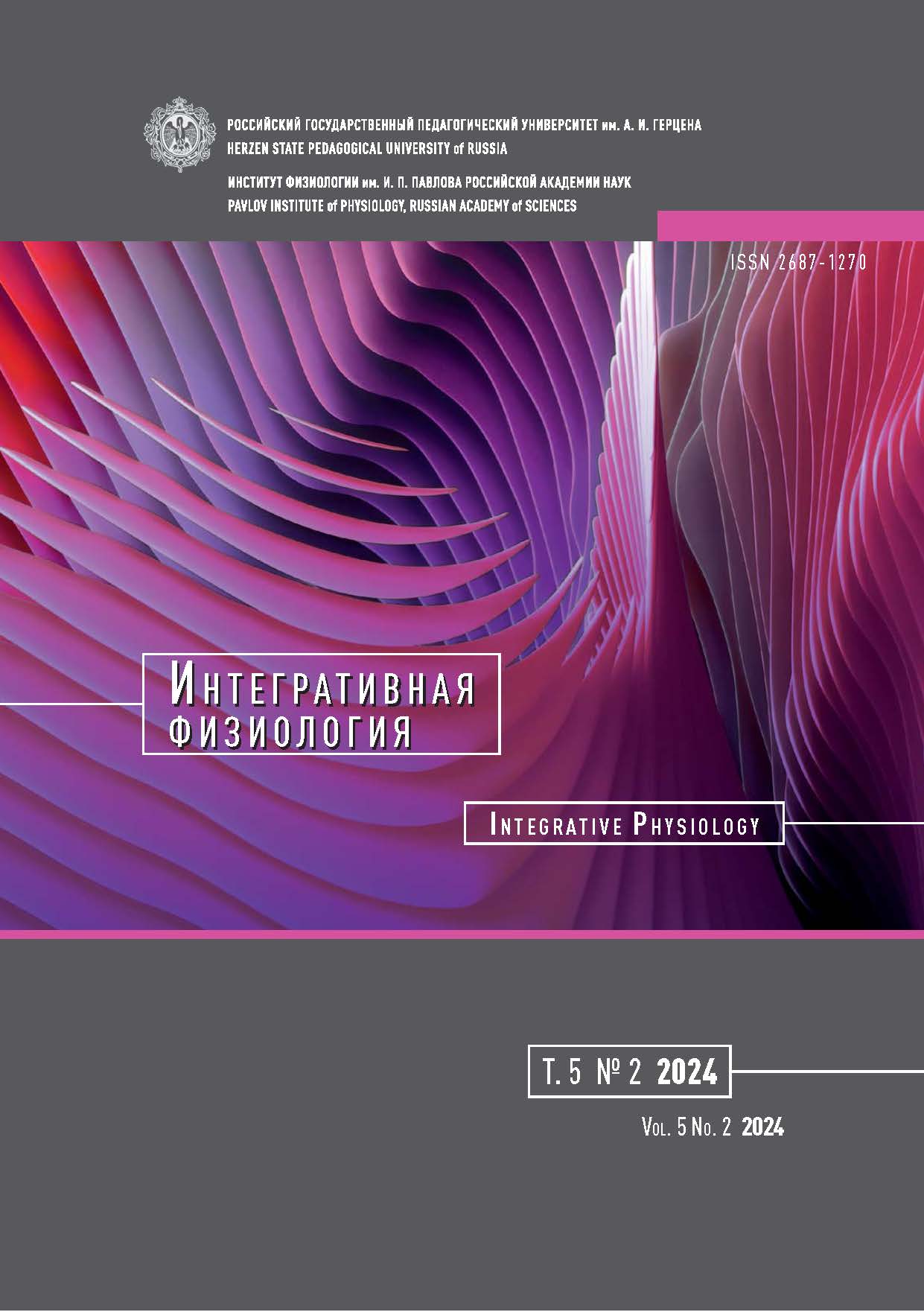Влияние сочетаний аминокислот и дипептидов на жизнеспособность культур тканей нервной и иммунной систем молодых и старых крыс
DOI:
https://doi.org/10.33910/2687-1270-2024-5-2-186-195Ключевые слова:
аминокислоты, дипептиды, жизнеспособность, органотипическая культура ткани, нервная система, иммунная системаАннотация
Одно из приоритетных направлений в современной биологии и медицине — изучение регуляторных механизмов повышения жизнеспособности многоклеточных систем. Многие из 20 кодируемых аминокислот стимулируют клеточную пролиферацию в органотипической культуре различных тканей экспериментальных животных. Также известно, что в основе физической жизнеспособности лежит скорость восстановления организма путем стимуляции клеток к пролиферации или апоптозу, осуществляемой под влиянием цитокинов и/или пептидов. В Санкт-Петербургском Институте биорегуляции и геронтологии была разработана технология выделения из различных органов и тканей телят полипептидных комплексов, влияющих на органотипическую культуру тканей экспериментальных животных. В состав полипептидных комплексов входят короткие пептиды — тетра-, три- и дипептиды, которые, являясь минорными компонентами исследованных полипептидных комплексов, обладают высокой биологической активностью. На основе этих данных может быть осуществлена разработка новых лекарственных препаратов, предназначенных для лечения и профилактики общих гериатрических синдромов (например, старческой астении), а также заболеваний различных органов с учетом принципа тканеспецифичности. Целью работы было исследование эффекта различных комбинаций L-аминокислот и дипептидов на жизнеспособность клеток в органотипической культуре ткани нервной и иммунной систем у крыс разного возраста.
Библиографические ссылки
ЛИТЕРАТУРА
Журкович, И. К., Ковров, Н. Г., Рыжак, Г. А. и др. (2020) Идентификация коротких пептидов в составе полипептидных комплексов, выделенных из органов животных. Успехи современной биологии, т. 140, № 2, с. 140–148. https://doi.org/10.31857/S004213242002012X
Рыжак, Г. А., Чалисова, Н. И., Линькова, Н. С. и др. (2015) Влияние полипептидов на регенерацию клеток в культуре разных тканей молодых и старых крыс. Успехи геронтологии, т. 28, № 1, с. 97–103.
Хавинсон, В. Х., Чалисова, Н. И., Линькова, Н. С. и др. (2015) Зависимость тканеспецифического действия пептидов от количества аминокислот, входящих в их состав. Фундаментальные исследования, № 2-3, с. 497–503.
Чалисова, Н. И., Иванова, П. Н., Егозова, Е. С., Никитина, Е. А. (2023) Стимулирующее влияние коротких пептидов на клеточную пролиферацию в органотипической культуре тканей. Интегративная физиология, т. 4, № 2, с. 225–234. https://doi.org/10.33910/2687-1270-2023-4-2-225-234
Чалисова, Н. И., Концевая, Е. А., Войцеховская, М. А., Комашня, А. В. (2011) Регуляторное влияние кодируемых аминокислот на основные клеточные процессы у молодых и старых животных. Успехи геронтологии, т. 24, № 2, с. 189–197.
Чалисова, Н. И., Никитина, Е. А., Александрова, М. Л., Золотоверхая, Е. А. (2021) Влияние кодируемых L-аминокислот на органотипическую культуру тканей различного генеза. Интегративная физиология, т. 2, № 2, с. 196–204. https://doi.org/10.33910/2687-1270-2021-2-2-196-204
Aftabuddin, M., Kundu, S. (2007) Hydrophobic, hydrophilic, and charged amino acid networks within protein. Biophysical Journal, vol. 93, no. 1, pp. 225–231. https://doi.org/10.1529/biophysj.106.098004
Anisimov, V. N., Khavinson, V. Kh. (2010) Peptide bioregulation of aging: Results and prospects. Biogerontology, vol. 11, no. 2, рр. 139–149. https://doi.org/10.1007/s10522-009-9249-8
Bender, D. A. (1983) Effects of a dietary excess of leucine on the metabolism of tryptophan in the rat: A mechanism for the pellagragenic action of leucine. British Journal of Nutrition, vol. 50, no. 1, pp. 25–32. https://doi.org/10.1079/bjn19830068
Bilen, M., Ibrahim, P., Barmo, N. et al. (2020) Methionine mediates resilience to chronic social defeat stress by epigenetic regulation of NMDA receptor subunit expression. Psychopharmacology, vol. 237, no. 10, pp. 3007– 3020. https://doi.org/10.1007/s00213-020-05588-8
Bisset, E. S., Howlett, S. E. (2022) The use of dietary supplements and amino acid restriction interventions to reduce frailty in pre-clinical models. Nutrients, vol. 14, no. 14, article 2806. https://doi.org/10.3390/nu14142806
Blank, H. M., Reuse, C., Schmidt-Hohagen, K. et al. (2023) Branched-chain amino acid synthesis is coupled to TOR activation early in the cell cycle in yeast. EMBO Reports, vol. 24, no. 9, article e57372. https://doi.org/10.15252/embr.202357372
Calabrese, V., Scuto, M., Salinaro, A. T. et al. (2020) Hydrogen sulfide and carnosine: Modulation of oxidative stress and inflammation in kidney and brain axis. Antioxidants, vol. 9, no. 12, article 1303. https://doi.org/10.3390/antiox9121303
Chalisova, N. I., Ivanova, P. N., Zalomaeva, E. S. et al. (2019) Effect of tryptophan and kynurenine on cell proliferation in tissue culture of the cerebral cortex in young and old rats. Advances in Gerontology, vol. 9, no. 2, pp. 186–189. https://doi.org/10.1134/S2079057019020073
Chiodi, I., Perini, C., Berardi D., Mondello, C. (2021) Asparagine sustains cellular proliferation and c Myc expression in glutamine starved cancer cells. Oncology Reports, vol. 45, no. 6, article 96. https://doi.org/10.3892/or.2021.8047
Coëffier, M., Claeyssens, S., Bensifi, M. et al. (2011) Influence of leucine on protein metabolism, phosphokinase expression, and cell proliferation in human duodenum1,3. American Journal of Clinical Nutrition, vol. 93, no. 6, pp. 1255–1262. https://doi.org/10.3945/ajcn.111.013649
Dai, J.-M., Yu, M.-X., Shen, Zh.-Y. et al. (2015) Leucine promotes proliferation and differentiation of primary preterm rat satellite cells in part through mTORC1 signaling pathway. Nutrients, vol. 7, no. 5, pp. 3387–3400. https://doi.org/10.3390/nu7053387
Fedoreyeva, L. I., Kireev, I. I., Khavinson, V. Kh., Vanyushin, B. F. (2011) Penetration of short fluorescence-labeled peptides into the nucleus in HeLa cells and in vitro specific interaction of the peptides with deoxyribooligonucleotides and DNA. Biochemistry (Moscow), vol. 76, no. 11, pp. 1210–1219. https://doi.org/10.1134/S0006297911110022
Gao, C., Cao, N., Wang, Y. (2021) The coming of age for branched-chain amino acids. Journal of Cardiovascular Aging, vol. 1, no. 2. https://doi.org/10.20517/jca.2021.02
Gonçalves, E. M., Gomes-Marcondes, M. C. C. (2010) Leucine affects the fibroblastic Vero cells stimulating the cell proliferation and modulating the proteolysis process. Amino Acids, vol. 38, no. 1, pp. 145–153. https://doi.org/10.1007/s00726-008-0222-7
Ivanova, P. N., Surma, S. V., Shchegolev, B. F. et al. (2018) The effects of weak static magnetic field on the development of organotypic tissue culture in rats. Doklady Biological Sciences, vol. 481, no. 4, pp. 132–134. https://doi.org/10.1134/S0012496618040075
Kandil, H. M., Argenzio, R. A., Chen, W. et al. (1995) L-glutamine and L-asparagine stimulate ODC activity and proliferation in a porcine jejunal enterocyte line. American Journal of Physiology, vol. 269, no. 1, pp. G591–G599. https://doi.org/10.1152/ajpgi.1995.269.4.G591
Masuoka, N., Lei, C., Li, H., Hisatsune, T. (2021) Influence of imidazole-dipeptides on cognitive status and preservation in elders: A narrative review. Nutrients, vol. 13, no. 2, article 397. https://doi.org/10.3390/nu13020397
Nishikawa, G., Kawada, K., Hanada, K. et al. (2022) Targeting asparagine synthetase in tumorgenicity using patient-derived tumor-initiating cells. Cells, vol. 11, no. 20, article 3273. https://doi.org/10.3390/cells11203273
Ostfeld, I., Hoffman, J. R. (2023) The effect of β-alanine supplementation on performance, cognitive function and resiliency in soldiers. Nutrients, vol. 15, no. 4, article 1039. https://doi.org/10.3390/nu15041039
Rezaei, R., Wu, G. (2022) Branched-chain amino acids regulate intracellular protein turnover in porcine mammary epithelial cells. Amino Acids, vol. 54, no. 11, pp. 1491–1504. https://doi.org/10.1007/s00726-022-03203-y
Richardson, N. E., Konon, E. N., Schuster, H. S. et al. (2021) Lifelong restriction of dietary branched-chain amino acids has sex-specific benefits for frailty and life span in mice. Nature Aging, vol. 1, no. 1, pp. 73–86. https://doi.org/10.1038/s43587-020-00006-2
Vanyushin, B. F., Khavinson, V. Kh. (2016) Short biologically active peptides as epigenetic modulators of gene activity. In: W. Doerfler, P. Böhm (eds.). Epigenetics — a different way of looking at genetics. Cham: Springer Publ., pp. 69–90. http://dx.doi.org/10.1007/978-3-319-27186-6_5
Vasconcelos, P. R., Guimarães, A. B., Campelo, M W. et al. (2015) Preconditioning with L-alanyl-glutamine upon cerebral edema and hypocampus red neurons counting in rats subjected to brain ischemia/reperfusion injury. Acta Cirúrgica Brasileira, vol. 30, no. 3, pp. 199–203. https://doi.org/10.1590/S0102-865020150030000006
Yu, Q., Wang, X., Wang, L. et al. (2016) Knockdown of asparagine synthetase (ASNS) suppresses cell proliferation and inhibits tumor growth in gastric cancer cells. Scandinavian Journal of Gastroenterology, vol. 51, no. 10, pp. 1220–1226. https://doi.org/10.1080/00365521.2016.1190399
Zalomaeva, E. S., Ivanova, P. N., Chalisova, N. I. et al. (2020) Effects of weak static magnetic field and oligopeptides on cell proliferation and cognitive functions in different animal species. Technical Physics, vol. 65, no. 10, pp. 1585–1590. https://doi.org/10.1134/S1063784220100254
REFERENCES
Aftabuddin, M., Kundu, S. (2007) Hydrophobic, hydrophilic, and charged amino acid networks within protein. Biophysical Journal, vol. 93, no. 1, pp. 225–231. https://doi.org/10.1529/biophysj.106.098004 (In English)
Anisimov, V. N., Khavinson, V. Kh. (2010) Peptide bioregulation of aging: Results and prospects. Biogerontology, vol. 11, no. 2, рр. 139–149. https://doi.org/10.1007/s10522-009-9249-8 (In English)
Bender, D. A. (1983) Effects of a dietary excess of leucine on the metabolism of tryptophan in the rat: A mechanism for the pellagragenic action of leucine. British Journal of Nutrition, vol. 50, no. 1, pp. 25–32. https://doi.org/10.1079/bjn19830068 (In English)
Bilen, M., Ibrahim, P., Barmo, N. et al. (2020) Methionine mediates resilience to chronic social defeat stress by epigenetic regulation of NMDA receptor subunit expression. Psychopharmacology, vol. 237, no. 10, pp. 3007– 3020. https://doi.org/10.1007/s00213-020-05588-8 (In English)
Bisset, E. S., Howlett, S. E. (2022) The use of dietary supplements and amino acid restriction interventions to reduce frailty in pre-clinical models. Nutrients, vol. 14, no. 14, article 2806. https://doi.org/10.3390/nu14142806 (In English)
Blank, H. M., Reuse, C., Schmidt-Hohagen, K. et al. (2023) Branched-chain amino acid synthesis is coupled to TOR activation early in the cell cycle in yeast. EMBO Reports, vol. 24, no. 9, article e57372. https://doi.org/10.15252/embr.202357372 (In English)
Calabrese, V., Scuto, M., Salinaro, A. T. et al. (2020) Hydrogen sulfide and carnosine: Modulation of oxidative stress and inflammation in kidney and brain axis. Antioxidants, vol. 9, no. 12, article 1303. https://doi.org/10.3390/antiox9121303 (In English)
Chalisova, N. I., Ivanova, P. N., Egozova, E. S., Nikitina, E. A. (2023) Stimuliruyuschee vliyanie korotkikh peptidov na kletochnuyu proliferatsiyu v organotipicheskoj kul’ture tkanej [The stimulating effect of short peptides on cellular proliferation in organotypic tissue culture]. Integrativnaya fiziologiya — Integrative Physiology, vol. 4, no. 2, pp. 225–234. https://doi.org/10.33910/2687-1270-2023-4-2-225-234 (In Russian)
Chalisova, N. I., Ivanova, P. N., Zalomaeva, E. S. et al. (2019) Effect of tryptophan and kynurenine on cell proliferation in tissue culture of the cerebral cortex in young and old rats. Advances in Gerontology, vol. 9, no. 2, pp. 186–189. https://doi.org/10.1134/S2079057019020073 (In English)
Chalisova, N. I., Kontsevaya, E. A., Voytzekhovskaya, M. A., Komashnya, A. V. (2011) Regulyatornoe vliyanie kodiruemykh aminokislot na kletochnye protsessy u molodykh i starykh zhivotnykh [Thew regulated effect of the coded amino acids on the basic cellular processes in young and old animals]. Uspekhi gerontologii, vol. 24, no. 2, pp. 189–197. (In Russian)
Chalisova, N. I., Nikitina, E. A., Alexandrova, M. L., Zolotoverkhaja, E. A. (2021) Vliyanie kodiruemykh L-aminokislot na organotipicheskuyu kul’turu tkanej razlichnogo geneza [The effect of coded L-amino acids on the organotypic culture of tissues of different]. Integrativnaya fiziologiya — Integrative Physiology, vol. 2, no. 2, pp. 196–204. https://doi.org/10.33910/2687-1270-2021-2-2-196-204 (In Russian)
Chiodi, I., Perini, C., Berardi, D., Mondello, C. (2021) Asparagine sustains cellular proliferation and c Myc expression in glutamine starved cancer cells. Oncology Reports, vol. 45, no. 6, article 96. https://doi.org/10.3892/or.2021.8047 (In English)
Coëffier, M., Claeyssens, S., Bensifi, M. et al. (2011) Influence of leucine on protein metabolism, phosphokinase expression, and cell proliferation in human duodenum1,3. American Journal of Clinical Nutrition, vol. 93, no. 6, pp. 1255–1262. https://doi.org/10.3945/ajcn.111.013649 (In English)
Dai, J.-M., Yu, M.-X., Shen, Zh.-Y. et al. (2015) Leucine promotes proliferation and differentiation of primary preterm rat satellite cells in part through mTORC1 signaling pathway. Nutrients, vol. 7, no. 5, pp. 3387–3400. https://doi.org/10.3390/nu7053387 (In English)
Fedoreyeva, L. I., Kireev, I. I., Khavinson, V. Kh., Vanyushin, B. F. (2011) Penetration of short fluorescence-labeled peptides into the nucleus in HeLa cells and in vitro specific interaction of the peptides with deoxyribooligonucleotides and DNA. Biochemistry (Moscow), vol. 76, no. 11, pp. 1210–1219. https://doi.org/10.1134/S0006297911110022 (In English)
Gao, C., Cao, N., Wang, Y. (2021) The coming of age for branched-chain amino acids. Journal of Cardiovascular Aging, vol. 1, no. 2. https://doi.org/10.20517/jca.2021.02 (In English)
Gonçalves, E. M., Gomes-Marcondes, M. C. C. (2010) Leucine affects the fibroblastic Vero cells stimulating the cell proliferation and modulating the proteolysis process. Amino Acids, vol. 38, no. 1, pp. 145–153. https://doi.org/10.1007/s00726-008-0222-7 (In English)
Ivanova, P. N., Surma, S. V., Shchegolev, B. F. et al. (2018) The effects of weak static magnetic field on the development of organotypic tissue culture in rats. Doklady Biological Sciences, vol. 481, no. 4, pp. 132–134. https://doi.org/10.1134/S0012496618040075 (In English)
Kandil, H. M., Argenzio, R. A., Chen, W. et al. (1995) L-glutamine and L-asparagine stimulate ODC activity and proliferation in a porcine jejunal enterocyte line. American Journal of Physiology, vol. 269, no. 1, pp. G591–G599. https://doi.org/10.1152/ajpgi.1995.269.4.G591 (In English)
Khavinson, V. K., Chalisova, N. I., Linkova, N. S. et al. (2015) Zavisimost’ tkanespetsificheskogo dejstviya peptidov ot kolichestva aminokislot, vkhodyashchikh v ikh sostav [ The dependence of tissue-specific peptides activity on the number of amino acids in the peptides]. Fundamental’nyye issledovaniya — Fundamental research, no. 2-3, pp. 497–503. (In Russian)
Masuoka, N., Lei, C., Li, H., Hisatsune, T. (2021) Influence of imidazole-dipeptides on cognitive status and preservation in elders: A narrative review. Nutrients, vol. 13, no. 2, article 397. https://doi.org/10.3390/nu13020397 (In English)
Nishikawa G., Kawada, K., Hanada, K. et al. (2022) Targeting asparagine synthetase in tumorgenicity using patient-derived tumor-initiating cells. Cells, vol. 11, no. 20, art. 3273. https://doi.org/10.3390/cells11203273 (In English)
Ostfeld, I., Hoffman, J. R. (2023) The effect of β-alanine supplementation on performance, cognitive function and resiliency in soldiers. Nutrients, vol. 15, no. 4, article 1039. https://doi.org/10.3390/nu15041039 (In English)
Rezaei, R., Wu, G. (2022) Branched-chain amino acids regulate intracellular protein turnover in porcine mammary epithelial cells. Amino Acids, vol. 54, no. 11, pp. 1491–1504. https://doi.org/10.1007/s00726-022-03203-y (In English)
Richardson, N. E., Konon, E. N., Schuster, H. S. et al. (2021) Lifelong restriction of dietary branched-chain amino acids has sex-specific benefits for frailty and lifespan in mice. Nature Aging, vol. 1, no. 1, pp. 73–86. https://doi. org/10.1038/s43587-020-00006-2 (In English)
Ryzhak, G. A., Chalisova, N. I., Linkova, N. S. et al. (2015) Vliaynie polipeptidov na regeneratsiyu kletok v culture raznykh tkaney molodykh i starykh krys [Polypeptides influence on tissue cell cultures regeneration of various rats]. Uspekhi gerontologii, vol. 28, no. 1, pp. 97–103. (In Russian)
Vanyushin, B. F., Khavinson, V. Kh. (2016) Short biologically active peptides as epigenetic modulators of gene activity. In: W. Doerfler, P. Böhm (eds.). Epigenetics — a different way of looking at genetics. Cham: Springer Publ., pp. 69–90. http://dx.doi.org/10.1007/978-3-319-27186-6_5 (In English)
Vasconcelos, P. R., Guimarães, A. B., Campelo, M. W. et al. (2015) Preconditioning with L-alanyl-glutamine upon cerebral edema and hypocampus red neurons counting in rats subjected to brain ischemia/reperfusion injury. Acta Cirúrgica Brasileira, vol. 30, no. 3, pp. 199–203. https://doi.org/10.1590/S0102-865020150030000006 (In English)
Yu, Q., Wang, X., Wang, L. et al. (2016) Knockdown of asparagine synthetase (ASNS) suppresses cell proliferation and inhibits tumor growth in gastric cancer cells. Scandinavian Journal of Gastroenterology, vol. 51, no. 10, pp. 1220–1226. https://doi.org/10.1080/00365521.2016.1190399 (In English)
Zalomaeva, E. S., Ivanova, P. N., Chalisova, N. I. et al. (2020) Effects of weak static magnetic field and oligopeptides on cell proliferation and cognitive functions in different animal species. Technical Physics, vol. 65, no. 10, pp. 1585–1590. https://doi.org/10.1134/S1063784220100254 (In English)
Zhurkovich, I. K., Kovrov, N. G., Ryzhak, G. A. et al. (2020) Identifikatsiya korotkikh peptidov v sostave polipeptidnykh kompleksov, vydelennykh iz organov zhivotnykh [Identification of short peptides as part of polypeptide complexes isolated from animal organs]. Uspeki sovremennoy biologii, vol. 140, no. 2, pp. 140–148. https://doi.org/10.31857/S004213242002012X (In Russian)
Загрузки
Опубликован
Выпуск
Раздел
Лицензия
Copyright (c) 2025 Наталья Иосифовна Чалисова, Галина Анатольевна Рыжак, Екатерина Александровна Никитина, Артемий Владимирович Рубинский

Это произведение доступно по лицензии Creative Commons «Attribution-NonCommercial» («Атрибуция — Некоммерческое использование») 4.0 Всемирная.
Авторы предоставляют материалы на условиях публичной оферты и лицензии CC BY 4.0. Эта лицензия позволяет неограниченному кругу лиц копировать и распространять материал на любом носителе и в любом формате в любых целях, делать ремиксы, видоизменять, и создавать новое, опираясь на этот материал в любых целях, включая коммерческие.
Данная лицензия сохраняет за автором права на статью, но разрешает другим свободно распространять, использовать и адаптировать работу при обязательном условии указания авторства. Пользователи должны предоставить корректную ссылку на оригинальную публикацию в нашем журнале, указать имена авторов и отметить факт внесения изменений (если таковые были).
Авторские права сохраняются за авторами. Лицензия CC BY 4.0 не передает права третьим лицам, а лишь предоставляет пользователям заранее данное разрешение на использование при соблюдении условия атрибуции. Любое использование будет происходить на условиях этой лицензии. Право на номер журнала как составное произведение принадлежит издателю.







